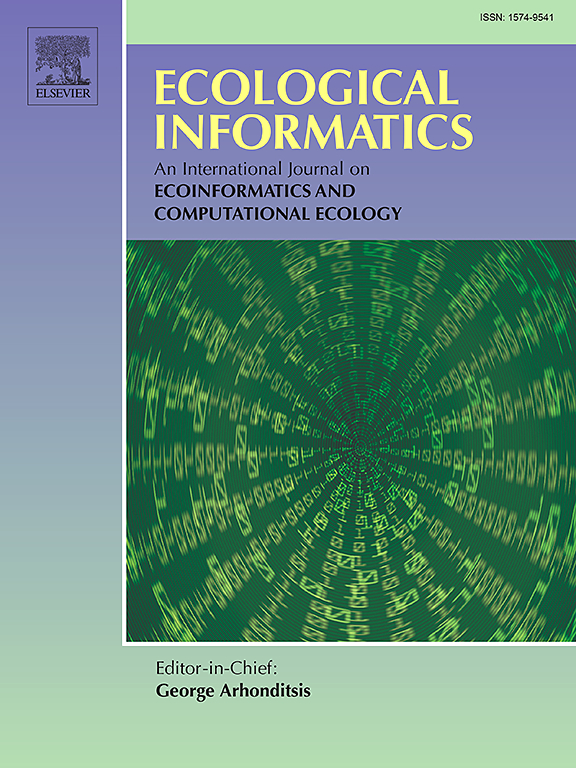Integrating species functional and architectural traits for improving crown width prediction in subtropical multispecies forests using nonlinear hierarchical models
IF 7.3
2区 环境科学与生态学
Q1 ECOLOGY
引用次数: 0
Abstract
Crown width (CW) is a critical predictor of individual tree development and forest ecosystem function. Effective CW models are well established for plantations and structurally simpler forests, yet their applicability to diverse, species-rich natural forests remains inadequate. In this study, we analyzed CW data from 1802 individual trees of 23 species in a subtropical natural forest to assess the effects of tree-specific variables, interspecies variability, neighborhood effects, and topographical factors on CW predictions. Specifically, we aimed to elucidate how variations in CW models among individual species can be accounted for based on species architectural and functional traits. Among various candidate base models, the logistic model most effectively captured the relationship between CW and diameter at breast height (DBH). Model accuracy was improved by incorporating individual tree height, crown length, neighborhood competition index, and elevation as explanatory variables. A nonlinear mixed-effects model highlighted the significant role of tree species identity as a random effect in accounting for interspecific variability in CW predictions. We integrated species-level functional and architectural traits as covariates in the hierarchical model. The results revealed that 62 % of the interspecific variation originally captured by the random effects of species was explained by leaf thickness and mean crown diameter to DBH ratio. Our results highlight the importance of accounting for species variability in CW modeling and suggest that including species traits as covariates significantly improves model accuracy and generalizability, particularly for previously neglected architectural traits. The results obtained in this study expand our understanding of crown growth patterns and offer an improved basis for modeling tree crown sizes in species-rich forests.
基于非线性层次模型整合物种功能和结构特征改进亚热带多树种林冠宽预测
冠宽(CW)是单株树木发育和森林生态系统功能的重要预测因子。对于人工林和结构较简单的森林,已经建立了有效的连续变化模型,但它们对多样性、物种丰富的天然林的适用性仍然不足。本研究分析了亚热带天然林23种树种1802株的CW数据,以评估树木特异性变量、种间变异、邻域效应和地形因子对CW预测的影响。具体来说,我们的目的是阐明如何基于物种的结构和功能特征来解释单个物种之间的CW模型的变化。在各种候选基础模型中,logistic模型最有效地捕获了胸径与胸高之间的关系。将单株树高、冠长、邻域竞争指数和海拔作为解释变量,提高了模型的精度。一个非线性混合效应模型强调了树种身份在CW预测中作为一种随机效应在解释种间变异性中的重要作用。我们将物种水平的功能和建筑特征作为协变量整合到层次模型中。结果表明,62%的种间变异可以用叶片厚度和平均冠径比来解释。我们的研究结果强调了在CW建模中考虑物种变异的重要性,并表明将物种特征作为协变量显著提高了模型的准确性和泛化性,特别是对于以前被忽视的建筑特征。本研究的结果扩大了我们对树冠生长模式的认识,并为物种丰富的森林中树冠大小的建模提供了改进的基础。
本文章由计算机程序翻译,如有差异,请以英文原文为准。
求助全文
约1分钟内获得全文
求助全文
来源期刊

Ecological Informatics
环境科学-生态学
CiteScore
8.30
自引率
11.80%
发文量
346
审稿时长
46 days
期刊介绍:
The journal Ecological Informatics is devoted to the publication of high quality, peer-reviewed articles on all aspects of computational ecology, data science and biogeography. The scope of the journal takes into account the data-intensive nature of ecology, the growing capacity of information technology to access, harness and leverage complex data as well as the critical need for informing sustainable management in view of global environmental and climate change.
The nature of the journal is interdisciplinary at the crossover between ecology and informatics. It focuses on novel concepts and techniques for image- and genome-based monitoring and interpretation, sensor- and multimedia-based data acquisition, internet-based data archiving and sharing, data assimilation, modelling and prediction of ecological data.
 求助内容:
求助内容: 应助结果提醒方式:
应助结果提醒方式:


